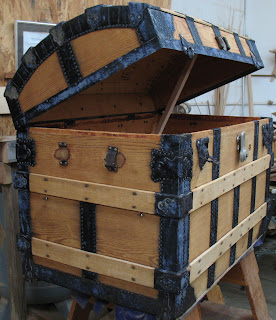A longtime customer of ours brought this old Newel Post in to us for stripping and some modification. In it's original location the stair rail wrapped around it in such a way that there were three places where the wood had to be cut to fit the rail.
In it's new home in our customer's house these cutouts in the wood would be very odd. The post was also about 3 inches to tall. Once the piece was stripped we cut three inches off the bottom of the post and saved this wood for the repairs on the top of the post.
Using the wood we saved from the base, we filled the three voids on the top of the post. This ensured that all the woods would match. We wouldn't have new wood mixing with old wood.
These areas would have to go on the lathe to be shaped so we actually cut a portion of the decorative top off. We had to be strategic about where we made this cut, so that it wasn't visible to the general viewer. This means we needed to make the cut under one of the turned curves.
The Newel Post repairs turned out very well. It will be much more functional in it's new space and could really be a centerpiece bit of architectural woodwork.












































